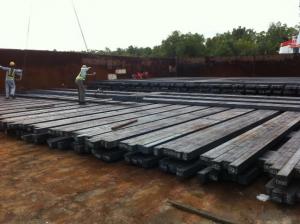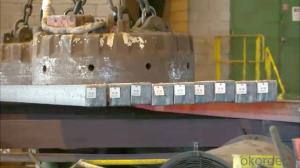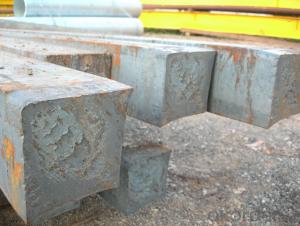Hot Rolled Square Steel Billet 3SP Standard 155mm
- Loading Port:
- Shanghai
- Payment Terms:
- TT OR LC
- Min Order Qty:
- 2000 m.t.
- Supply Capability:
- 10000 m.t./month
OKorder Service Pledge
OKorder Financial Service
You Might Also Like
Structure of Hot Rolled Square Steel Billet 3SP Standard 155mm

Description of Hot Rolled Square Steel Billet 3SP Standard 155mm
PPGI is made by cold rolled steel sheet and galvanized steel sheets as baseplate, through the surface pretreatment (degreasing, cleaning, chemical conversion processing), coated by the method of continuous coatings (roller coating method),
and after roasting and cooling. Zinc coating: Z60, Z80, Z100, Z120, Z180, Z275, G30, G60, G90
Alu-zinc coating: AZ60, AZ80, AZ100, AZ120, AZ180, G30, G60, G90
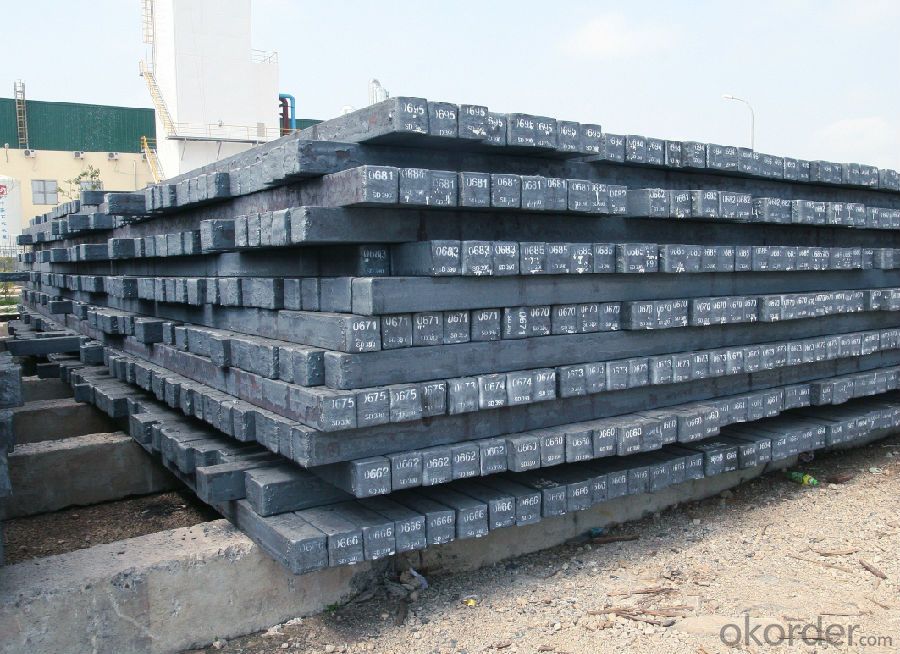
Main Feature of Hot Rolled Square Steel Billet 3SP Standard 155mm
1) Excellent corrosion resistance: The zinc layer provides a good protection of Pre-painted Galvanizeed Steel Sheet.
2) High heat resistance: The reflective surface of the material aids in efficiently reflecting the sunlight away and in turn reducing the amount of heat transmitted. The thermal reflectivity converts into energy savings.
3) Aesthetics: Pre-Painted Galvanized steel sheet is available in plethora of patterns and multiple sizes as per the requirements that given by our customers.
4) Versatility: can be used in the various areas.Standard seaworthy export packing: 3 layers of packing, inside is kraft paper, water plastic film is in the middle and outside GI steel sheet to be covered by steel strips with lock, with inner coil sleeve.
Applications of Hot Rolled Square Steel Billet 3SP Standard 155mm
1) Automotive bodies: filters, fuel tanks, etc.
2) Construction materials: roofings, welding pipes,
3) Electric and electronic appliances: computer cans, etc.
4) Steel cans: containers, etc.
5) Steel furniture: washing machines, refrigerators, microwaves, etc.
6) Drums
7) Office equipment: printer, recorders, etc.
8) Motors and transformers
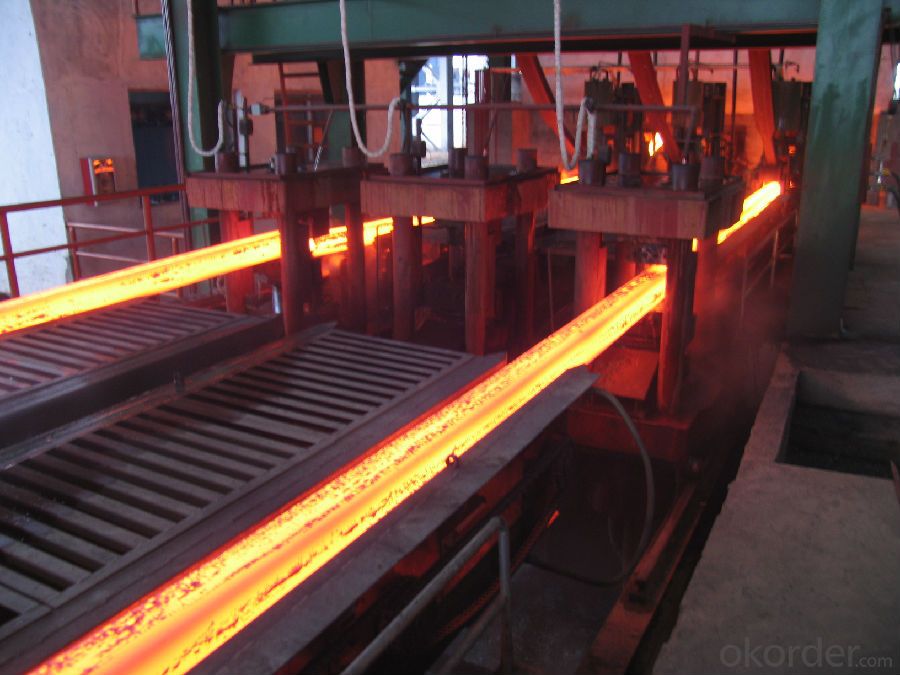
Specifications of Hot Rolled Square Steel Billet 3SP Standard 155mm
| Classified symbol | Yield Point Minimum N/mm2 | Tensile Strength Minimum | Elongation Minimum % | Application | ||||
| N/mm2 | Nominal Thickness mm (t) | |||||||
| JIS | Yogic | 0.25-0.4 | 0.4-0.6 | 0.6-1.0 | 1.0-1.6 | |||
| G3312 | specification | |||||||
| CGCC | CGCC | -205 | -270 | -20 | -21 | -24 | -24 | Commercial |
| CGCD | CGCD | --- | 270 | --- | 27 | 31 | 32 | Drawing |
| --- | CG340 | 245 | 340 | 20 | 20 | 20 | 20 | Structural |
| CGC400 | CG400 | 295 | 400 | 16 | 17 | 18 | 18 | Structural |
| CGC440 | CG440 | 335 | 440 | 14 | 15 | 16 | 18 | Structural |
| CGC490 | CG490 | 365 | 490 | 12 | 13 | 14 | 16 | Structural |
| CGC570 | CG570 | 560 | 570 | --- | --- | --- | --- | Structural |
| ASTM Designation | Yield Point Minimum | Tensile Strength Minimum | Elongation Minimum % | Application | Q/BQB 445-2004(China standard) | ASM A653/A653M | JISG 3312 | |
| ksi(MPa) | ksi(MPa) | TDC51D+Z | (CS TYPE A+Z) | CGCC | ||||
| A653(M)-99 CS TYPE A,B,C | --- | --- | --- | Commercial | TDC52D+Z | CGCD | ||
| A653(M)-99 FS | --- | --- | --- | Lock Forming | TS250GD+Z | (G250+Z) | - | |
| A653(M)-99 DS | --- | --- | --- | Drawing | TS300GS+Z | (G300+Z) | CGC 400 | |
| A653(M)-99 SS Grade33(230) | 33(230) | 45(310) | 20 | Structural | TS350GD+Z | (G350+Z) | CGC490 | |
| A653(M)-99 SS Grade37(255) | 37(255) | 52(360) | 18 | Structural | TS550GD+Z | (G550+Z) | CGC570 | |
| A653(M)-99 SS Grade40(275) | 40(275) | 55(380) | 16 | Structural | ||||
| A653(M)-99 SS Grade50(345) | 50(345) | 65(450) | 12 | Structural | ||||
| A653(M)-99 SS Grade80(550) | 80(550) | 82(570) | --- | Structural | ||||
FAQ of Hot Rolled Square Steel Billet 3SP Standard 155mm
We have organized several common questions for our clients,may help you sincerely:
1. How Can I Visit There?
Our company is located in Tianjin City, China, near Beijing. You can fly to Tianjin Airport Directly. All our clients, from home or aboard, are warmly welcome to visit us!
2. How Can I Get Some Sample?
We are honored to offer you sample.
3. Why choose CNBM?
1, ISO, BV, CE, SGS approved.
2, Competitive price and quality.
3, Efficient service team online for 24 hours.
4, Smooth production ability(50000tons/month) .
5, quick delivery and standard exporting package.
6, Flexible payment with T/T, L/C, Paypal, Kunlun bank, etc.
- Q:How is the quality of steel billets determined?
- The quality of steel billets is determined through various factors including chemical composition, physical properties, and visual inspection. Chemical composition analysis involves measuring the levels of different elements present in the billets such as carbon, manganese, and sulfur, as well as checking for any impurities. Physical properties such as tensile strength, hardness, and toughness are tested to ensure the billets meet the required specifications. Visual inspection is also performed to identify any defects like cracks, surface abnormalities, or unevenness. Combining these assessments helps determine the overall quality of steel billets.
- Q:How do steel billets contribute to the manufacturing of industrial machinery?
- The manufacturing of industrial machinery heavily relies on steel billets, which are semi-finished steel products molded into specific shapes and sizes. These billets serve as the raw material for producing various components and parts used in industrial machinery. To begin with, steel billets provide the necessary strength and durability required by industrial machinery. The high tensile strength and toughness of steel make it an ideal choice for withstanding heavy loads, vibrations, and extreme conditions that machinery often faces. By utilizing steel billets, manufacturers can ensure that the machinery they produce is capable of enduring these demanding conditions, thus increasing its reliability and longevity. Additionally, steel billets can be easily molded and shaped into different forms, allowing for the production of intricate and complex components. Precision-engineered parts tailored to specific functions and applications are often necessary for industrial machinery. Steel billets can be cast or forged into these intricate shapes, guaranteeing that the machinery operates with optimal efficiency and accuracy. Furthermore, steel billets possess excellent machinability, meaning they can be easily cut, drilled, and shaped using various machining techniques. This capability enables the creation of intricate details and tolerances required for the precise functioning of industrial machinery. The ability to machine steel billets with precision grants manufacturers the opportunity to produce components that fit together seamlessly, minimizing any potential performance issues. Moreover, steel billets offer a cost-effective solution for manufacturing industrial machinery. Steel is readily available and relatively inexpensive compared to other materials. Its superior strength-to-weight ratio also allows manufacturers to design lighter machinery without compromising its structural integrity. This reduction in manufacturing costs also makes the machinery more portable and easier to transport. Furthermore, steel billets provide excellent corrosion resistance, which is vital for industrial machinery operating in harsh environments. The protective oxide layer that forms on the surface of steel billets helps prevent rust and corrosion, ensuring that the machinery remains in optimal working condition even in challenging situations. In conclusion, the strength, durability, machinability, cost-effectiveness, and corrosion resistance offered by steel billets make them essential in the manufacturing of industrial machinery. These properties enable manufacturers to produce reliable, precise, and long-lasting machinery capable of withstanding demanding industrial applications.
- Q:What are the different methods of steel billet surface polishing?
- There are multiple techniques available for polishing the surface of steel billets, each with its own benefits and uses. These techniques consist of mechanical polishing, chemical polishing, electrochemical polishing, and abrasive blasting. Mechanical polishing is a widely employed method that employs abrasive materials to eliminate surface flaws and create a smooth outcome. It can be done manually using sandpaper or with the aid of machinery like buffing machines or belt sanders. This technique effectively removes scratches, oxidation, and other imperfections on the surface, resulting in a polished and reflective appearance. Chemical polishing is a non-mechanical approach that relies on chemical reactions to eliminate surface flaws. It involves immersing the steel billet in a chemical solution that dissolves a thin layer of the material, resulting in a smoother surface. Chemical polishing is commonly used for intricate or delicate components, as it can achieve a high level of precision and uniformity. Electrochemical polishing, also known as electropolishing, is a technique that combines chemical and electrical processes to polish the surface of the steel billet. It involves immersing the billet in an electrolyte solution and applying an electric current. The electric current removes microscopic peaks and imperfections, resulting in a smoother and brighter surface. Electrochemical polishing is frequently used for stainless steel billets due to its ability to eliminate surface contaminants and enhance corrosion resistance. Abrasive blasting, also referred to as sandblasting, is a technique that utilizes high-pressure air or water to propel abrasive materials onto the surface of the steel billet. This process effectively eliminates rust, scale, and other surface contaminants, resulting in a clean and textured finish. Abrasive blasting can be performed using various abrasive materials such as sand, steel shot, or glass beads, depending on the desired surface finish. In conclusion, the various techniques for polishing the surface of steel billets include mechanical polishing, chemical polishing, electrochemical polishing, and abrasive blasting. Each technique offers its own advantages and applications, providing a range of options to achieve the desired surface finish for steel billets.
- Q:Can steel billets be used in the aerospace industry?
- Indeed, the aerospace industry does make use of steel billets. These billets, classified as semi-finished products, can undergo further processing to create the diverse components and structures necessary for aerospace purposes. The strength, durability, and heat resistance of steel are well-known attributes that prove vital in aerospace materials. By employing steel billets, one can fabricate a range of aerospace components, including engine parts, landing gear, structural frames, and fasteners. Furthermore, steel's availability and cost-effectiveness enhance its appeal for specific aerospace applications. Nonetheless, it is imperative to acknowledge that adhering to the aerospace industry's specific requirements and standards is crucial when employing steel billets, ensuring the utmost levels of safety and reliability.
- Q:What is the role of steel billets in the construction industry?
- Steel billets are of great importance in the construction industry as they serve as the primary raw material for producing various steel products used in construction projects. These billets, which are semi-finished steel forms, can be hot-rolled or forged into different shapes and sizes like bars, rods, beams, and wire. The primary purpose of steel billets is to provide the necessary strength, durability, and structural integrity to buildings, bridges, and other infrastructure. They are utilized in constructing foundations, columns, beams, and other load-bearing structures where their high tensile strength and resistance to external forces are crucial. Moreover, steel billets are extensively employed in reinforcement applications. They are utilized to create reinforcing steel bars, also known as rebars, which are embedded within concrete structures to enhance their strength and resistance to tension. These rebars play a critical role in preventing cracks and failures in concrete structures, ensuring their long-term stability and safety. Additionally, steel billets are used in the manufacturing of various construction components such as pipes, tubes, and wires. These components are essential for plumbing, electrical wiring, and other utility installations in buildings and infrastructure projects. In conclusion, steel billets are a fundamental raw material in the construction industry. Their versatility, strength, and durability make them indispensable for creating sturdy and reliable structures, reinforcing concrete elements, and manufacturing essential construction components.
- Q:How are steel billets used in the production of agricultural harvesting equipment?
- Steel billets are a crucial component in the production of agricultural harvesting equipment due to their strength, durability, and versatility. These billets are typically used to create the main structural framework of various types of agricultural machinery, such as combine harvesters, threshers, and balers. One of the primary applications of steel billets in the production of agricultural harvesting equipment is in the construction of the machine's frame. The frame serves as the backbone of the equipment, providing stability and support for all other components. Steel billets are ideal for this purpose as they have high tensile strength, allowing them to withstand the heavy loads and stresses encountered during harvesting operations. Additionally, steel billets are also utilized to manufacture various critical components of agricultural machinery. For example, they are often used to produce cutting blades, augers, and conveyors, which are essential for efficiently harvesting and processing crops. Steel's excellent wear resistance and toughness make it an ideal material for these components, as they need to withstand the abrasion and impact caused by contact with crops and other debris. Furthermore, steel billets are commonly employed in the manufacturing of hoppers, chutes, and other storage and transportation systems within agricultural harvesting equipment. These components are responsible for collecting, sorting, and transferring harvested crops, and therefore need to be robust and reliable. Steel billets provide the necessary strength and rigidity to ensure the efficient handling and movement of agricultural products. In summary, steel billets play a vital role in the production of agricultural harvesting equipment. Their strength, durability, and versatility make them indispensable for creating the main structural framework, critical components, and storage systems of these machines. By utilizing steel billets, manufacturers can ensure the production of reliable and efficient agricultural machinery that can withstand the demanding conditions of harvesting operations.
- Q:What is the global production capacity of steel billets?
- Accurately estimating the global production capacity of steel billets proves challenging due to its annual fluctuations and susceptibility to factors like market demand, economic conditions, and technological advancements. Nonetheless, the World Steel Association reports that in 2019, the total global production capacity for steel billets stood at around 1.86 billion metric tons. This capacity is distributed among different countries and steel-producing regions, with China leading as the largest producer, trailed by India, Japan, and the United States. It is crucial to acknowledge that these statistics are subject to alteration as the steel industry evolves and grows.
- Q:Are steel billets subject to any heat treatment processes?
- Yes, steel billets are subject to heat treatment processes. Heat treatment processes such as annealing, normalizing, quenching, and tempering can be applied to steel billets to enhance their mechanical properties and improve their overall performance.
- Q:How are steel billets used in the production of construction parts?
- Steel billets serve as a vital raw material for manufacturing construction parts. They are essentially semi-finished steel products that are cast into square or rectangular shapes. These billets undergo further processing to create various construction components, such as beams, columns, rods, and bars. To begin utilizing steel billets, they are first heated in a furnace to a temperature that allows for easy deformation and shaping. Once the billets reach the desired temperature, they are then passed through a series of rolling mills, where they undergo hot rolling. This process involves repeatedly passing the billets through multiple pairs of rollers to gradually reduce their size and shape them into the necessary form, such as beams or rods. Hot rolling not only shapes the billets but also enhances their mechanical properties, including strength, toughness, and ductility. After hot rolling, the resulting steel products are cut to the desired lengths and further processed, if required, to meet specific construction requirements. These steel components, derived from billets, are extensively used in construction projects. For example, beams made from steel billets are commonly employed to provide structural support in buildings and bridges. Due to their exceptional strength and load-bearing capacity, they are ideal for withstanding heavy loads and ensuring overall stability. Conversely, steel rods and bars find widespread use in reinforced concrete construction. These components are embedded within the concrete to enhance its tensile strength and prevent the formation of cracks. They play a vital role in constructing foundations, slabs, walls, and other structural elements that require additional reinforcement. In conclusion, steel billets are of immense importance in the production of construction parts, serving as the starting point for the manufacturing process. Through hot rolling and subsequent processing, these billets are transformed into various steel components that provide structural support, reinforcement, and durability in construction projects.
- Q:What is the role of steel billets in the manufacturing of wind turbines?
- The manufacturing of wind turbines heavily relies on steel billets, which are semi-finished steel products that usually come in rectangular or square shapes. These billets are used as raw materials to produce various wind turbine components. One vital application of steel billets in wind turbine manufacturing is for constructing the tower. The tower needs to possess exceptional strength and stability to bear the weight of the entire structure and withstand wind forces. Steel's high strength-to-weight ratio makes it an ideal material for tower construction. Initially, steel billets are cut and shaped into cylindrical sections, which are then welded together to form the tower structure. This ensures the tower's robustness and ability to withstand the harsh environmental conditions faced by wind turbines. Furthermore, steel billets find usage in manufacturing other components like the rotor hub and nacelle. The rotor hub connects the blades to the main shaft, while the nacelle houses the gearbox and generator. These components require high durability and reliability to ensure optimal wind turbine performance. Steel billets are meticulously molded and machined to obtain the desired shapes for creating these components, providing the necessary strength and structural integrity. Additionally, steel billets are employed in the production of various smaller parts essential for assembling and securing different wind turbine components, such as brackets, bolts, and fasteners. To summarize, steel billets form the foundation for wind turbine manufacturing. They are transformed into strong structures and components that constitute the essential parts of these renewable energy systems. Their strength, durability, and versatility make them vital materials in wind turbine production, guaranteeing reliable operation and contributing to sustainable energy generation.
1. Manufacturer Overview |
|
|---|---|
| Location | |
| Year Established | |
| Annual Output Value | |
| Main Markets | |
| Company Certifications | |
2. Manufacturer Certificates |
|
|---|---|
| a) Certification Name | |
| Range | |
| Reference | |
| Validity Period | |
3. Manufacturer Capability |
|
|---|---|
| a)Trade Capacity | |
| Nearest Port | |
| Export Percentage | |
| No.of Employees in Trade Department | |
| Language Spoken: | |
| b)Factory Information | |
| Factory Size: | |
| No. of Production Lines | |
| Contract Manufacturing | |
| Product Price Range | |
Send your message to us
Hot Rolled Square Steel Billet 3SP Standard 155mm
- Loading Port:
- Shanghai
- Payment Terms:
- TT OR LC
- Min Order Qty:
- 2000 m.t.
- Supply Capability:
- 10000 m.t./month
OKorder Service Pledge
OKorder Financial Service
Similar products
New products
Hot products
Hot Searches
Related keywords



